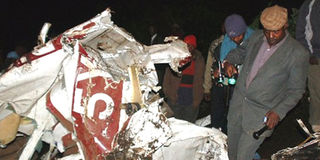Plane that killed Kones had no insurance cover

Onlookers at the site of the plane crash that killed former ministers Kipkalya Kones and Lorna Laboso on June 10, 2008 in Enoospukia, Narok. Investigators have discovered that the chartered plane that was to transport Mr Kones and Ms Laboso to Kericho for a campaign stop, did not have insurance for passengers. Photos/FILE
Families of the former ministers Kipkalya Kones and Lorna Laboso are unlikely to be compensated after it emerged on Wednesday that the ill-fated plane had no passenger insurance cover.
Investigators have discovered that the chartered plane that was to transport Mr Kones and Ms Laboso to Kericho for a campaign stop, did not have insurance for passengers.
Flight planning
They also found that the pilot did not make proper preparations before taking off from Wilson Airport, Nairobi, on June 10, last year. “He did not pick weather information from the briefing office to aid in his flight planning,” says the team in their final report.
And the team recommended that the Office of the President should come up with guidelines on group travel by Cabinet ministers, assistant ministers and other senior government officials.There has been concern about the tendency by top government officials to travel in a group especially by air.
This was brought to the fore when some Cabinet ministers and assistant ministers escaped death narrowly when a plane transporting them from a victory party for former Vice-President Moody Awori crashed in Busia Town.
Just last week, a military aircraft transporting President Kibaki on a tour of Kisii was forced to land after one of its engines started emitting smoke.
And the investigation does not spare the Kenya Civil Aviation Authority and Meteorological department either.
The aviation authority was blamed for inadequate safety surveillance over operations of the company, which owned the plane, Skytrades Limited, while the Meteorology department was accused of offering generalised weather reports.
This was the verdict of the team of aviation experts that investigated the crash of the single-engine Cessna 210E at Enoosupukia in Narok South District, Rift Valley province last year.
According to players in the insurance industry, the families of the victims would have been entitled to between Sh1 million to Sh5 million as individual compensation payout. However, the families will miss out on this as the aircraft did not also have an insurance cover for any baggage or mail that might have been lost.
Parliament has already paid the families of the two ministers Sh10 million each for the loss.
Charter aircraft
The crash, which occurred on June 10 last year, also claimed the lives of Kones’ bodyguard Kennedy Bett and the pilot Christopher Schner. The charter aircraft from Wilson Airport to Kericho crashed some 20 minutes after takeoff into high ground over the Mau escarpment in conditions of poor visibility.
The party were on their way to Ainamoi to monitor the by-election resulting from the death of the MP Kimutai Too when the crash occurred.
In their final report released to the media on Wednesday, the team of investigators who were led by Mr Peter Wakahia, said the accident was “not survivable” due to the high velocity impact.
“The aircraft disintegrated on impact and the seats were thrown outside the cabin... No one could have survived the crash,” read the report.
Other members of the team of investigators were Mr Anthony Kirokien, Mr Enos Ndoli, Mr Peter Munyao and Mathioya MP Clement Wambugu, a member of the Parliamentary Committee on Energy, Transport and Roads.
The team had 90 days from June last year, to investigate the crash and present the findings to the minister. Their findings will now be presented to the Cabinet and Parliament for deliberations before it is adopted.
The investigators say the accident, which was largely blamed on poor weather and pilot error, could have been avoided had the aircraft been flying at the required “safe flight level.”’
The aircraft, according to the report, was not also equipped with a ground proximity warning system which could have indicated to the pilot that he was cruising at the required safe flight level.
Questions were also raised as to why Pilot Christopher Schner was allowed to operate the aeroplane despite the fact that he did not meet his company’s minimum flying experience and qualifications.




